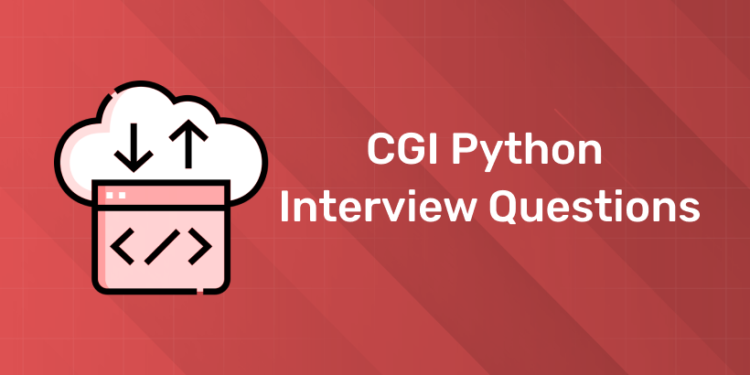Table of Contents
In the world of web development Python is a beast, especially when it comes to server side scripting. One of the key aspect of this is the Common Gateway Interface (CGI) which allows web servers to execute python scripts and generate dynamic content. You should be well prepared if you are preparing for a technical interview that focuses on Python, especially for roles that require knowledge of CGI.This post will cover the questions you might face, why you should master CGI Python and how to prepare.
Introduction: CGI in Python
Common Gateway Interface (CGI) is a protocol that allows web servers to execute external programs, usually scripts, to generate dynamic content for web pages. We can write these scripts in any programming language, including Python. In short, CGI allows web servers to talk to Python scripts, process user inputs (like form submissions) and return customized responses to users. Understanding CGI is a must for any web developer who wants to build interactive web applications.
Why CGI Python?
1: Which of the following data types is immutable in Python?
Master CGI with Python and you have several opportunities in web development. Here’s why you should:
- Dynamic Web Applications: CGI allows you to create highly dynamic and interactive web applications by processing user input in real-time.
- Cross-Platform: CGI scripts written in Python can run on any platform, so your skills are highly portable.
- Simplified Web Development: Python’s simplicity + CGI = easy to develop and maintain web applications.
- Database Integration: You can easily integrate CGI scripts in Python with databases to build data-driven applications.
🚀 Start Coding Today! Enroll Now with Easy EMI Options. 💳✨
Gain expertise in Django and open doors to lucrative opportunities in web development.
Start Learning With EMI Payment OptionsCGI Interview Preparation
To prepare for a CGI Python interview you need to have good grasp of both Python programming and CGI. Here are some tips to help you:
- Understand CGI Basics: Ensure that you have a good understanding of how CGI works, how it integrates with web servers, and how you can use it to generate dynamic web content.
- Practice Writing CGI Scripts: Hands on practice is key. Write several CGI scripts in Python, focusing on common tasks like processing form data, managing sessions and handling file uploads.
- Revise Python Fundamentals: Brush up on your Python basics, data structures, control flow, and functions, as these are often tested in technical interviews.
- Learn about Web Servers: Knowing how web servers like Apache or Nginx execute CGI scripts will give you an edge in interviews.
- Review Security Best Practices: CGI scripts can be a security risk if not handled properly. Make sure you know how to write secure CGI scripts that sanitize inputs and handle errors correctly.
Top CGI Python Interview Questions and Answers
1. What is CGI in Python?
Answer: CGI stands for Common Gateway Interface, a standard protocol that allows web servers to execute external programs, usually scripts, to generate dynamic content. In Python, CGI scripts can handle web forms, interact with databases, and dynamically generate web pages.
2. How do you write a simple CGI script in Python?
Answer: A simple CGI script in Python starts with the #!/usr/bin/env python3 shebang and includes the cgi module to handle form data. Here’s an example:
#!/usr/bin/env python3
import cgi
print("Content-Type: text/html\n")
print("<html><body>")
print("<h1>Hello, World!</h1>")
print("</body></html>")
3. How do you process form data in a Python CGI script?
Answer: Form data in a Python CGI script is processed using the FieldStorage class from the cgi module. This class parses the form data sent via GET or POST methods and makes it accessible within the script. Here’s an example:
import cgi
form = cgi.FieldStorage()
name = form.getvalue('name')
print("Content-Type: text/html\r\n\r\n")
print(f"<html><body><h1>Hello, {name}!</h1></body></html>")
4. How do you handle file uploads in CGI using Python?
Answer: To handle file uploads, use the cgi.FieldStorage object and write the uploaded file to the server. Example:
form = cgi.FieldStorage()
fileitem = form['file']
if fileitem.filename:
with open(f'/path/to/uploads/{fileitem.filename}', 'wb') as f:
f.write(fileitem.file.read())
5. What are the common headers used in CGI scripts?
Answer: The most common headers are Content-Type, which defines the MIME type of the response (e.g., text/html), and Status, which specifies the HTTP status code (e.g., 200 OK).
6. What are the risks and how can you prevent them?
Answer: CGI scripts can be risky if not handled properly. Here are some of the risks:
- Injection Attacks: Unsanitized user input can lead to command injection or SQL injection attacks.
- Information Disclosure: Poor error handling can expose your server’s sensitive info to users.
- File Permission Issues: Incorrect file permissions can allow access to scripts or data without permission.
To prevent these risks, always validate and sanitize user input, don’t expose sensitive info in errors and make sure your CGI scripts and directories have the right permissions.
7. What’s the difference between GET and POST in CGI?
Answer: GET appends form data to the URL, visible in the browser’s address bar. It’s used for retrieving data and should not be used for sending sensitive info. POST sends form data in the HTTP request body, not visible in the URL, good for sensitive or large data.
8. How do you do file uploads in CGI using Python?
Answers: File uploads in a CGI script are managed using the FieldStorage class. Here’s an example of handling file uploads in a Python CGI script:
import cgi, os
form = cgi.FieldStorage()
fileitem = form['file']
if fileitem.filename:
filepath = os.path.join('/path/to/uploads', os.path.basename(fileitem.filename))
with open(filepath, 'wb') as f:
f.write(fileitem.file.read())
message = 'File uploaded successfully'
else:
message = 'No file was uploaded'print(f"<html><body><h1>{message}</h1></body></html>")
9. What is the role of the Content-Type header in CGI?
Answer: The Content-Type header is important in CGI scripts because it tells the browser what to expect. For example Content-Type: text/html means the server is sending back an HTML document. This header must be included in the CGI script’s output before any other content is sent to the browser.
10. Can you explain the difference between CGI and WSGI?
Answer: CGI and WSGI (Web Server Gateway Interface) are both protocols for talking to web servers and web applications. The main difference is CGI creates a new process for each HTTP request which can be resource intensive. WSGI is a more modern and efficient standard for Python web applications, the web server can talk directly to the Python application without the overhead of creating a new process for each request.
11. How do you debug a Python CGI script?
Answer: Debugging a Python CGI script is tough because there is no direct output during execution. Here are the steps to debug:
- Check Server Logs: Look at the server’s error logs for any error messages.
- Print Debugging: Use print statements to output variables and execution flow to the HTML output.
- Error Handling: Implement try-except blocks to catch and handle errors in the script.
- File Permissions: Ensure that your CGI script and its directory have the correct permissions to be executed by the server.
Get hands-on with our python course – sign up for a free demo!
12. How do you handle errors in CGI scripts?
Answer: Use try-except blocks to catch exceptions, log errors and give user friendly error messages without showing server internal details.
13. What is the Content-Type header in CGI?
Answer: The Content-Type header tells the browser what to expect, text/html for HTML documents or application/json for JSON data.
14. How do you pass parameters to a CGI script?
Answer: You can pass parameters via the query string in the URL (for GET requests) or as part of the body (for POST requests). They can be accessed using the cgi.FieldStorage object.
15. What is the shebang line in CGI scripts?
Answer: The shebang line (#!/usr/bin/env python3) at the top of the script tells the server which interpreter to use to run the script.
16. How do you handle sessions in CGI?
Answer: We can manage sessions by storing session data in cookies or server-side files/databases and associating it with a unique session ID sent to the client.
17. What is cgi.escape() and why is it important?
Answer: Developers used the cgi.escape() function (deprecated in Python 3) to escape special characters in strings to prevent HTML injection attacks. It’s important for sanitizing user inputs that will be displayed as HTML.
18. What is the typical directory structure for CGI scripts?
Answer: Web servers usually store CGI scripts in a specific directory, often named cgi-bin.. This directory needs to have the correct permissions to run scripts.
19. How do you debug CGI scripts?
Answer: We can debug by checking server error logs, printing debug information to the HTML output, and using Python’s pdb debugger for step-by-step execution.
20. How do you configure a web server to run CGI scripts?
Answer: Configuration depends on the server. For Apache, CGI scripts are enabled by setting the ScriptAlias directive and making sure ExecCGI is allowed for the directory.
Get hands-on with our python course – sign up for a free demo!
Conclusion: CGI Python for Web Development
CGI in Python is a must have skill for any web developer. You can create dynamic and interactive web applications by processing user inputs in real time. By mastering CGI you can enhance your web development skills and be ready for technical roles that requires this skill.
If you want to deepen your Python skills, consider joining Entri’s Python Programming Course. This course covers all the essential Python topics including web development and will help you build a solid foundation for your career. With Entri’s course you can gain the knowledge and confidence to rock your Python programming journey.
Start your journey towards becoming a Python expert today with Entri’s Python Programming Course. Enroll Now and take the first step towards a successful career in Python development.
Related Articles
| Our Other Courses | ||
| MEP Course | Quantity Surveying Course | Montessori Teachers Training Course |
| Performance Marketing Course | Practical Accounting Course | Yoga Teachers Training Course |
🚀 Start Coding Today! Enroll Now with Easy EMI Options. 💳✨
Gain expertise in Django and open doors to lucrative opportunities in web development.
Start Learning With EMI Payment OptionsFrequently Asked Questions
What is CGI in Python?
CGI (Common Gateway Interface) in Python is a protocol that allows web servers to execute scripts and generate dynamic content, enabling interactive web applications.
Why is CGI important for web development?
CGI is essential for creating dynamic web content, handling user inputs, and generating real-time responses, making it a foundational tool for web developers.
How do I prepare for a CGI Python interview?
To prepare, focus on understanding CGI concepts, practice writing and debugging CGI scripts, and review common CGI interview questions. Enrolling in Entri’s Python programming course can also help.
What are some common CGI Python interview questions?
Questions may include topics like writing simple CGI scripts, handling file uploads, managing sessions, and understanding security best practices in CGI.
How can Entri's Python programming course help me?
Entri’s Python programming course offers comprehensive training, covering essential topics like CGI, web development, and more, helping you build the skills needed to succeed in technical interviews.













